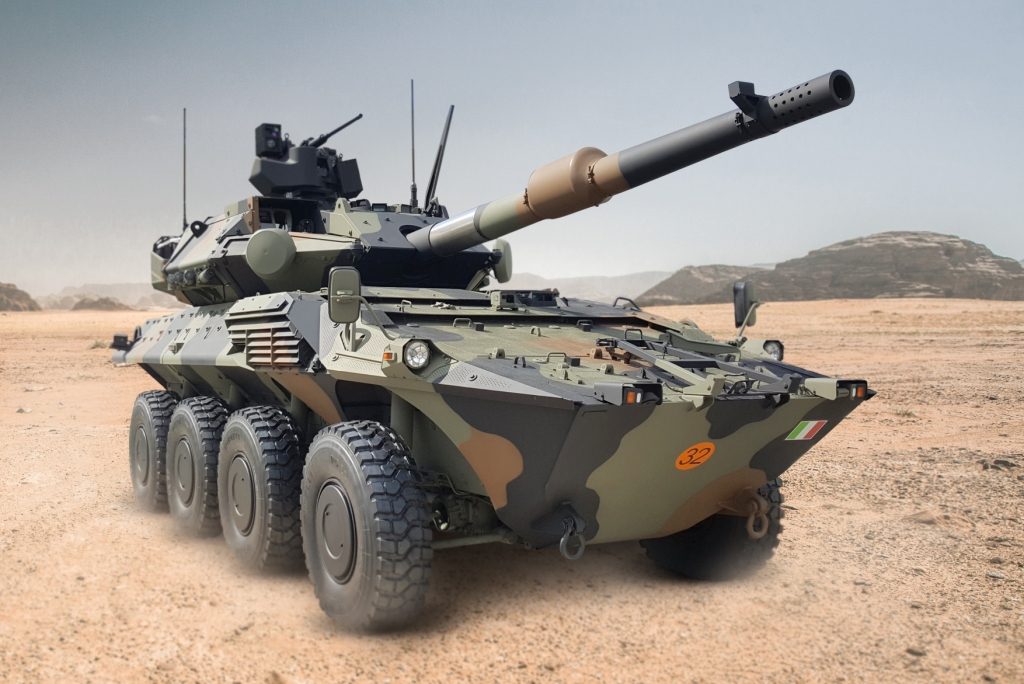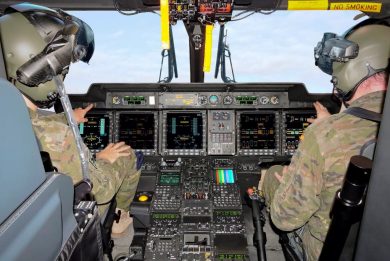
Leonardo promotes its 105/52 mm Mk II gun on the Centauro II
If Eurosatory would have taken place visitors would have found a peculiar layout at the Leonardo stand: a Centauro II armoured car armed with a 105 mm gun, with the 120 mm gun put aside the vehicle, quite a different story compared to last editions. The main Italian defence group intended promoting its 105 mm gun as in the previous editions the new 8×8 mobile gun system had been exhibited with the 120 mm gun selected by the Italian Army fitted. In fact the turret for the new vehicle, known as HITFACT Mk II, can be armed with the 120 or 105 mm gun, depending on customer’s choice. The decision to promote the smaller of the two calibres is due to the fact that demand from the market is still high for the 105, Leonardo Defence Systems told EDR On-Line.
Switching from one gun to the other is relatively simple, the turret remaining exactly the same as the interfaces with both guns are the same, the only major difference being the weight, the 120 mm weighing around 750 kg more that the smaller calibre gun.
The two guns have the same origin, as they were developed in parallel, using the same materiel and technologies, and compared to the former 105 mm, installed on the original Centauro, differences are considerable. The company decided to keep the same profile of the gun in order to simplify the expensive qualification process; it would have been possible to reduce the barrel thickness, thus lowering the barrel weight, however this remained unchanged which now gives a considerable growth margin, should new ammunition with higher pressure be developed. The materiel adopted for the barrel featured improved performances compared to that used in the old gun, namely yielding S0.2% was increased by 45%, extensibility by 30%, resilience Kv (40°K) was reduced by 20%, while fracture toughness was increased by 30%. The oscillating mass of the new ordnance, known as HITFACT Mk II 105/52 mm gun, is reduced by 5% while the recoil length is 20% shorter. The 20% higher admissible breech pressure is where the growth margin is found, and currently some companies, are developing improved 105 mm ammunition that would exploit that margin. Beside the growth margin building the chrome-lined barrel with a more efficient materiel while keeping the barrel thickness had two beneficial effects; on one hand it increased the safety margin while on the other it this should ensure a longer life, at least from the physical wear standpoint. Leonardo Defence Systems started building a HITFACT MkII turret that will be used by the company to demonstrate both options to potential customers, many nations being still looking for such calibre, a choice that makes sense if and when their armed forces are not confronted to main battle tank, or at least not to those of the latest generations, a 105 mm gun being therefore sufficient to neutralise them, while keeping a considerable flexibility due to the numerous types of ammunition developed in that calibre available at a fraction of the cost of the most recent addition to the 120 mm ammunition range, especially those fitted with programmable fuses.
That said, the work on the 120 mm gun is definitely ongoing; fully qualified, it is in use on the Omani Centauros, installed in the legacy turret, and it is installed on the Italian Army Centauro II, which first vehicles in the 2.0 configuration should be delivered later this year, Leonardo Defence Systems is currently working on the integration of the programming system that will allow Italian mobile gun systems to use the Rheinmetall DM11 multipurpose round. This will provide the service with a flexible direct fire support, adding to APFSDS rounds, for which the 120 mm smoothbore gun was developed in the 1970s, an ammunition capable to cope with a wide range of targets, as it can be used to open breaches in concrete walls, to neutralise antitank and machine gun positions in trenches, as well as infantry in the open ground. The Centauro II prototype fitted with this capability, which is known as 3.0, should start qualification trials in September.
Photo courtesy Leonardo



